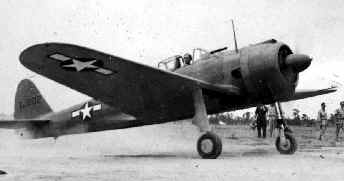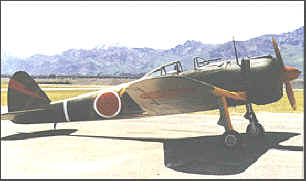 |
|
|||
|
|
|
|
KI 43 Type 1 "OSCAR" fighter (light bomber capability) |
 |
 |
|
Note the US markings on the plane to the left. Photo taken of a captured Oscar after the war. |
|
|
The Ki-43 Type 1 Hayabusa (Peregrine Falcon) was the most widely flown fighter of the Japanese Army Air Force during the war (Allied code name Oscar). Entering squadron service shortly before the Pearl Harbor attack, the Oscar was highly manoeuvrable with a good rate of climb, but somewhat underpowered and, despite updates, unable to compete effectively with U.S. fighters in the latter stages of the war. An official USAAF analysis, however, described later models as "an increasingly dangerous opponent." The Oscar saw combat in all Pacific areas where the Japanese Army conducted air operations, and most Japanese Army Aces scored most of their kills in this aircraft. At the end of the war the Oscar was employed with the Army's Taiatari (suicide) units. First flown in Jan. 1939, the Oscar was designed by Nakajima engineer Hideo Tonkawa. Army pilots initially disliked the fighter, which they found less manoeuvrable than its predecessor, the Ki-27 Ante. The Oscar was modified, primarily with a "butterfly flap" that was extended in combat to provide additional lift, increase turn rate, and improve control response. The Oscar remained in production throughout the war. Only forty Oscars were in Army service at the time of Pearl Harbor. A more-powerful engine and other features characterized the Ki-43-II, put in production in 1943 and the Ki-43-III, produced from Dec. 1944. Oscar production totalled 5,919 units. The Oscar was also flown by the Thai Air Force. (After the war they were also flown by Indonesians against the Dutch, and briefly, by the French in the Indochina (Viet Nam) conflict.) The Oscar was a simple, streamlined aircraft; the radial-engine, low-wing aircraft resembled the A6M Zero and to some extent Western fighters. It had a bubble canopy and was one of the first Japanese fighters to have armour; later models were also fitted with protected fuel tanks. The major production variant, the Ki-43-II, had a maximum speed of 329 mph, which was increased in the IIIa to 358 mph. Normal range for the II was 1,095 miles, extended to 1,990 miles with a drop tank, reflecting the Japanese interest in long-range fighter operations. Most aircraft had two 12.7-mm machine guns, making them highly under gunned by Western standards. The IIIb variant, of which only two prototypes were produced, instead had two 20-mm cannon. The II and III variants could carry two 551-pound bombs. |
